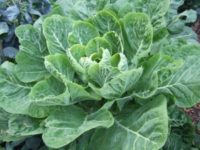Kale & Collards
 Kale has been virtually ignored by Southern California gardeners because of its cold tolerance and heat sensitivity. Actually, collards grow better for us. Kale is a super green containing twice the daily recommended allowance of Vitamin A and almost as much Vitamin C as peppers. Kale is also low in oxalic acid so its calcium can be utilized by the body. Kale isn't only cold tolerant; it prefers temperatures between 40 and 60 - 65 degrees and becomes tough and bitter at 75 degrees. Cold actually makes it super sweet. It is hardy and easy to grow in this area where January temperatures are sometimes in the 70s.
Kale has been virtually ignored by Southern California gardeners because of its cold tolerance and heat sensitivity. Actually, collards grow better for us. Kale is a super green containing twice the daily recommended allowance of Vitamin A and almost as much Vitamin C as peppers. Kale is also low in oxalic acid so its calcium can be utilized by the body. Kale isn't only cold tolerant; it prefers temperatures between 40 and 60 - 65 degrees and becomes tough and bitter at 75 degrees. Cold actually makes it super sweet. It is hardy and easy to grow in this area where January temperatures are sometimes in the 70s.
Direct seeding the first of October will produce a crop during the colder winter months. It will take about 90 days to get plants large enough to harvest; thinnings can be eaten too. There are three categories: Dwarf, Siberian and Chinese (also called Chinese broccoli)
Collards are not much different from kale. They differ in appearance and collards grow larger than kale, to 3 feet tall and 2 feet wide, with large smooth leaves. Collards don't have the super resistance from freezing, although they will survive down to 15 degrees F. Collards are a non-heading cabbage and have a cabbage flavor.
Harvest like Kale, cutting tender leaves - not the biggest -leaving the center to produce more. Tear out the midrib which is tough and should be discarded. Young leaves have a sweet flavor and older leaves are often bitter.
Planting Dates
Coastal:
Start seed in October for a fall and winter green or Feb. to March for a spring crop.
Inland:
Start seed in October for a fall and winter green or Feb. to March for a spring crop.

